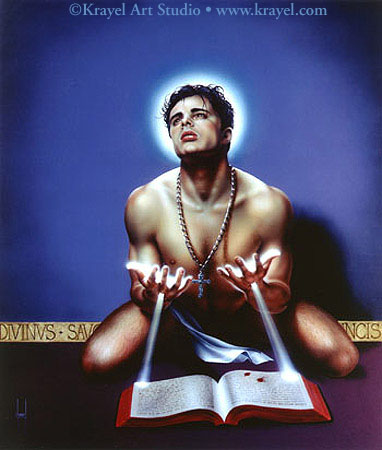![]()
![]()
![]()
![]()
![]()
![]()
![]()
![]()
![]()
![]()
![]()
![]()
![]()
![]()
![]()
![]()
![]()
![]()
![]()
![]()
![]()
![]()
![]()
|
|

St Francis of Assisi Receiving the Stigmata
1995
| SAINT FRANCIS OF ASSISI (1181 - 1226) Born the son of a wealthy cloth merchant of Assisi, Francis was originally christened John, but called Francesco, i.e. the Frenchman, because he was born while his father was in France. In his youth he was devoted to the ideas of romantic chivalry propagated by the troubadours. Uninterested alike in his father's business and formal learning, he had plenty of money, spent it lavishly, if not ostentatiously, and was also a leader of society in the town. When Francis was about twenty, war broke out between Assisi and Perugia and he spent a year imprisoned by the Perugians. Upon his release, he was struck down by a long and serious illness. Already his regard for lepers and the poor was conspicuous. Riding one day across the plain of Assisi, he met a leper whose sores were so loathsome that he was struck with horror at the sight of them. But our Saint dismounted, and as the leper stretched out his hand to receive an alms, Francis, whilst he bestowed it, kissed the man. Henceforward he often visited the hospitals and served the sick and gave to the poor, sometimes his clothes and sometimes money. A little later while praying in the small, semi-derelict church of San Damian, he heard a voice which seemed to come from the Byzantine-style crucifix. Three times the saint was told, "Go and repair my house, which you see is falling down." He returned home, took a horseload of cloth from his father's warehouse and sold it, with the horse. However, the poor priest of St. Damian's would not take the money, which Francis then left on a window-sill, but eventually consented to let Francis stay with him. Francis's father, upon finding his son disfigured and ill-clad after spending several days in prayer and fasting, carried him home, beat him unmercifully, put shackles on his feet and locked him up, where he remained until his mother set him free while his father was out. His father, now more annoyed than ever, followed Francis's return to the church, hit him about the head and insisted that he should either return home or renounce all his share in his inheritance and return the purchase price of the goods he had taken. Francis had no objection to being disinherited, but said that the other money now belonged to God and the poor. This conflict with his father was not resolved until Francis was at last summoned before the Bishop of Assisi. There, Francis dramatically renounced his inheritance and added, "The clothes I wear are also his. I'll give them back." He suited the action to the word, stripped himself of his clothes and gave them to his father. After which the Bishop provided Francis with the simple garment of a labourer. Thus, with many thanks, he received his first alms, made a cross on the garment with chalk and put it on. Francis now experienced extreme and deliberately chosen poverty. For the repair of the church he gathered alms and begged in Assisi, where all had known him wealthy. Now carrying a staff and wearing the same clothes given to him two years ago by the Bishop, he bore the contempt of the townspeople with joy. Considered mad, he was pelted with stones, beaten and thrown into a ditch. After rebuilding St. Damian, Francis did the same for an old church which was dedicated in honor of St Peter. Many began to admire Francis, and some desired to be his companions and disciples. When his followers had increased to a dozen, Francis drew up a short informal consisting chiefly of the gospel counsels of perfection, emphasizing absolute poverty, humility and discipline. Out of humility, St Francis gave to his order the name of Friars Minor. Over the next several years, foundations had been made outside Italy and the friars now extended beyond the Alps with missions being sent to Spain, Germany and Hungary. Yet, the order began to suffer from its own success. By 1219, the numbers had become large (estimated at 5000), and yet there was no proper novitiate, no organization, and only the simplest of rules. In 1221, Francis drew up another Rule which was approved two years later and canalized the Franciscan Order into the Church. To his later years, while he no longer held an official position in the Order, belong some of the most famous incidents of Francis's life. The saint retired to Mount Alvernia and there made a little cell. It was here during a state of ecstasy that the miracle of the stigmata happened. Having been thus marked with the signs of Christ's wounds inflicted during the crucifixion, Francis tried to conceal this favor of Heaven from the eyes of men, and for this purpose, he ever after covered his hands with his habit and wore shoes and stockings on his feet. The stigmata were a source of constant physical pain and weakness. His health soon began to fail and the next year, Francis became blind. He endured agonies from primitive surgery and other medical treatment and died at last, aged only forty-five. Francis's close rapport with the animal creation is believed to represent the saint's return to a state of innocence enjoyed by Adam in Eden. His preaching to the birds was and is a favorite scene from his life, as is the story of the wolf of Gubbio, tamed by Francis's words. It is this which makes him an apt patron saint of animals and ecology. Feast day October 4 |
|
|
|


